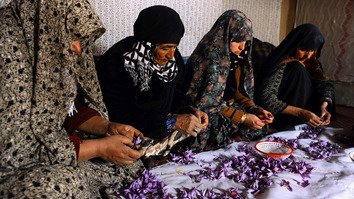KUNDUZ -- Women in Balkh Province are becoming more interested in growing saffron with the help of the provincial government.
Currently, 270 farmers, including 90 women, are busy growing saffron plants on 270 jeribs (54 hectares) of land throughout 10 districts of Balkh Province, said Mohammad Salem Saayee, director of the Balkh Agriculture, Irrigation and Livestock Department (BAILD).
"The saffron plant is grown in Balkh, Khulm, Sholgara, Chahar Bolak, Kishindih, Dawlatabad, Dehdadi, Nahr-e-Shahi and Zari districts," Saayee said.
"We are trying to expand saffron planting to more areas next year and encourage more women to grow this religiously and legally allowed plant," he added.
"Saffron planting has taken over poppy cultivation in Balkh Province, which is a source of great pride for farmers in Balkh," he said.
Poppy cultivation has been nil in the province over the last two years, according to Saayee.
Poppy cultivation is most often linked to the Taliban, which uses illegal narcotics to fund its militancy. The insurgents force farmers to grow poppies, even though the cultivation, transport, trafficking, sale and use of narcotic drugs are strictly forbidden in Islam.
The Taliban have long been Afghanistan's top drug cartel, say Afghan and international officials.
The Taliban earn more than 46.8 billion AFN ($600 million) from poppy cultivation and the drug business in Afghanistan per year, according to some accounts. The drugs cultivated in Afghanistan reach the international market mainly via illegal routes in Pakistan and Iran.
The illicit drug industry is big business in Afghanistan, as the United Nations Office on Drugs and Crime (UNODC) has made clear in annual reports. The gross value of the Afghan opiate economy was somewhere between $1.2 billion and $2.2 billion (92.2 billion and 169.1 billion AFN) in 2018, according to the UNODC's "Afghanistan opium survey 2018".
Growing interest
BAILD has launched programmes to train women in the growth, care and collection of saffron to prepare them for the next year, said Saayee.
"We intend to increase the number of female saffron growers to 150-200, so that like men, these women can also grow and collect saffron," he said.
"I got training in growing saffron last year. This year I have grown saffron on 1 jerib (0.2 hectare) of land on a pilot basis," said Salima, a 35-year-old resident of Kishindih District.
Salima said that she had heard much about the benefits of growing saffron from others and now wants to make it her source of income.
"I learned a lot. This year, officials from [BAILD] provided us with uniforms and equipment to wear while collecting saffron," she said.
"Compared to other agricultural products, the saffron plant requires less effort to grow while the income is higher. Therefore, we have started growing saffron more than any other plant," said Atifa, a 29-year-old saffron grower in Balkh District.
"I grew saffron plants on 1 jerib (0.2 hectare) of land and got [a yield of] 1kg of saffron from it," she said.
"We did not know about the benefits of saffron. Now that we are trained and know its benefits, we want to grow saffron next year," said Gulsom, a 29-year-old resident of Sholgara District.
"I was jobless, and women in the village encouraged me to get involved in agriculture. I am now getting ready to grow saffron next year," she said.
Finding markets
Afghan farmers and exporters of saffron are benefiting from surging prices in national and international markets after the government banned imports of low-quality Iranian saffron.
Prices of Afghan saffron doubled after President Ashraf Ghani banned the imports of the spice from Iran in October 2018. The move was aimed at preserving Afghan saffron's international brand, retaining quality, boosting prices and expanding production of the spice.
Imports of saffron from Iran have plunged to zero, Abdul Saboor Rahmani, the director of the Herat Department of Agriculture, said last June.
"Prices of saffron have doubled in the past three months," Rahmani added. "Currently, 1kg of saffron is sold for 60,000-90,000 AFN ($750-$1,130) based on its quality."
In Balkh Province, saffron production is supported by three processing companies, according to Saayee, director of BAILD.
They buy saffron from farmers and sell them in domestic and international markets after processing and packaging it, he said.
"Besides these companies, the Balkh Saffron Growers Association, which operates under the umbrella of [BAILD], has also been able to provide good markets for saffron growers," Saayee said.
"The average harvest of saffron from 1 jerib of land is 1.5kg. We are trying to increase the level of the harvest to go up to 2kg in the coming years," he said.
Saffron growers in Balkh say they produce the finest saffron in Afghanistan.
"Saffron from Balkh has attracted good buyers both from inside Afghanistan and outside the country in the last five years," said Sayed Shah Halim, a member of the Balkh Saffron Growers Association.
"Other countries, especially India, are ready to buy our products," he said.

![Afghan women harvest saffron December 12, 2018, in Balkh District, Balkh Province. [Balkh Agriculture, Irrigation and Livestock Department]](/cnmi_st/images/2020/02/07/22335-a__10_-585_329.jpg)






